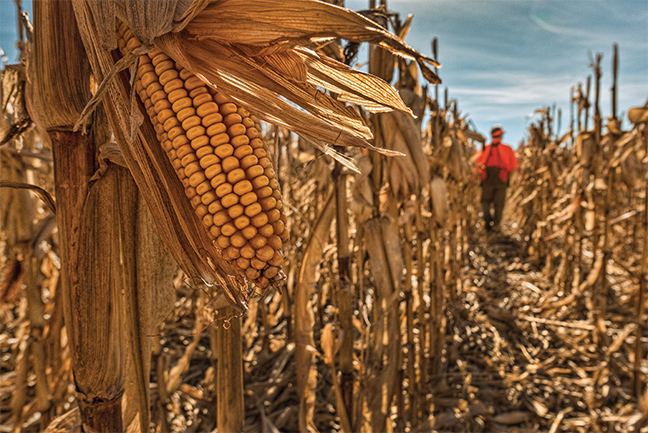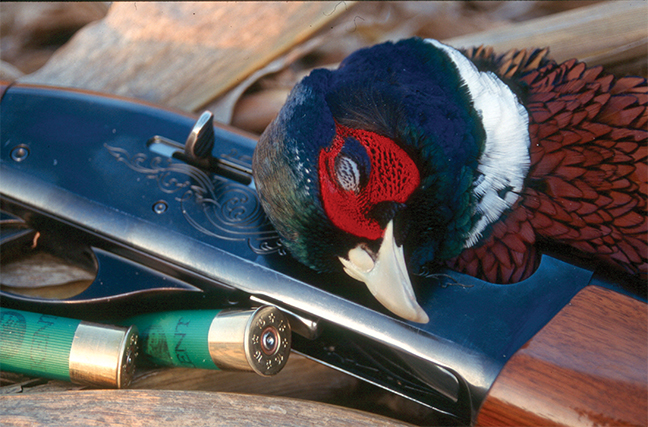
If a rooster pheasant were one of Batman’s archenemies, he’d be the Joker. The common denominator of both bird and Bad Guy? Neither of them plays fair, especially Mister Ringneck.
So how do you pin down such a slippery character? Well, for starters, you find out where he lives. Where he spends his time. And why he’s there. Next, you research his weaknesses — those habits than make him less than perfectly elusive. And finally, you develop tactics to exploit those weaknesses, using his shortcomings to your advantage.
It’s October, so let’s look closely at two of the ringneck’s preferred early season haunts — corn and cattails — and how best to attack this pair of perennial favorites.
CORN
In many areas where corn is planted as a large-scale crop, 95 percent or more of it will still be standing come the first week of October. And standing corn offers, at best, terrible hunting conditions.
Why? First, modern agricultural practices ensure little to no row-to-row cover in today’s 21st Century cornfields. No foxtail. No goldenrod. No reed canary grass. Just dirt sidewalks devoid of any weeds. Yields are maximized, but that doesn’t do much for pheasants and pheasant hunters.
Roosters do love standing corn, mainly for the overhead protection it provides; but again, overhead protection does little for the human predator. Second, standing corn is almost impossible for one or two hunters to work effectively. It’s noisy, and because it’s “clean” of weedy plants it allows pheasants to see us long before we see them.
Meanwhile, it can be difficult for hunting dogs and hunters to keep track of each other in standing corn. And finally, and with little exception, few farmers are going to grant permission to six guys asking to bulldoze through his corn. It’s simple economics there.
That’s the bad news about pheasants, October, and standing corn. The good news is corn is still an asset to the pheasant hunter; however, his approach to the crop needs to focus not on the crop itself, but whatever might be around it — that is, the more “huntable” cover immediately adjacent to it.
Even the largest cornfield has an edge, and as simple as it sounds, that’s where you want to focus your efforts. This will be a bit more challenging than merely walking through knee-high brome grass with standing corn off your left shoulder, and tagging a three-bird limit of roosters. Successfully hunting the edges along standing corn requires some strategy. And that means both tactics designed for you and, if you have one, your bird dog.
Gunning roosters along standing corn involves first understanding two variables — where, and when. Typically, pheasants won’t roost or spend the night in modern cornfields for the simple fact there’s no cover there. They will roost in adjoining cover, and will typically, as morning progresses, migrate toward the edge between corn and cover. Here, they have everything they need — the corn’s nearby overhead cover, bare dirt with grit, the ability to see predators, access to seeds and insects, and some 360-degree protection in the adjacent heavy grass.
What this means to the pheasant hunter is a return to the concept of strategy. If you hunt with a dog — ours were Labrador retrievers, both pointing and non-pointers — absolute control and obedience is paramount now. Pheasants are notoriously skittish; a dog that doesn’t stay extremely close, one that doesn’t obey non-verbal direction (i.e., low-volume whistle commands), won’t necessarily flush birds wild, but will send birds scurrying into the protection of the standing corn, where they will be almost impossible to roust.
The key here is to let the dogs hunt — let them to do their job — but keep them close and always under control.
Second, be quiet. Stealth certainly does play a role in successfully hunting standing corn. Quiet means no shouted commands to the dog. No yelling “Over here! Over here! Seeing anything!!??” back and forth to your hunting partner or partners.
No slamming car doors, shotgun actions, or thinking you can silently slip down to the end of the field between cornrows three and four. Pheasants, like the majority of wild game birds, can hear extremely well. And once they hear you, it’s off to the races — and they run faster than you can.
Finally, keep your numbers small and have a plan. Unless you’re in a group of 15 guns or more — which, granted, can at times be effective, albeit quite the logistical undertaking — a pair of hunters is plenty to work corn edges.
As for a plan, we’ll assume two guns here. Typically, rousted roosters will try to fly toward cover that is heavier than where they were originally flushed. Knowing this, one gun walks quietly at the edge of the standing corn; the second, and the one with the well-mannered and close-working dog, exacts a slow zigzag pattern parallel to and perhaps 30 to 50 yards off the shoulder of the first.
Ideally, birds that don’t go straight away from the man/dog team will make a beeline for the standing corn, and that’s where the silent solo gun waits. One-man pushes can also be tried. Ideally, the man/dog duo works into the wind toward a corner of the standing corn where an earlier quietly positioned hunter stands.

One last trick to try while hunting standing corn. Everywhere Daylight Savings Time takes effect in late October, dusk comes earlier in the day. And approaching dark means time for birds to come out of the corn where they’ve spent the day and head for overnight cover.
As close to the end of legal shooting time as possible watch for cockbirds that fly out of the corn, and mark their landing accurately. A quick but quiet approach just might put you into position for a flush and shot.
CATTAILS
Cattails are another phenomenal pheasant cover; however, like standing corn, they’re not without their challenges. One of the most significant is the water commonly associated with cattails. Pheasants don’t like to be wet. And second, cattails are tough enough to hunt when dry; add the water element, and cattails become almost impossible to work efficiently.
That said, pheasants love cattails for the protection they provide, so to ignore the cover is to ignore a good number of birds.
But how to hunt this impenetrable mass of vegetation? You could wait until the water freezes. This makes the cover much more accessible to both hunter and hunted; however, this is in many places a late-season tactic.
In the early season cattails still present a couple of different strategic options. Hunting the edges, as one does with standing corn, is one; the other is to search out those sections of marsh that are still dry following summer’s heat. As mentioned, pheasants dearly love these thick hideouts, and will pull out all the stops when it comes to self-preservation — running and burrowing into the mats, either before or after taking flight.
Cattails lend themselves perfectly to big, strong dogs. Our Labs liked nothing more than rooting roosters out of right-of-way stands of cattails. Still, such dogs need to be controlled and close-working — qualities which are often not a problem, thanks to the twisted web of broad-leafed marsh vegetation.
October, November, or January. Standing corn or cattail marsh. The calendar or the cover mean little to ringneck pheasants, who practice the art of evasion 365 days each year, and who will use either type of cover to full advantage. A quiet, stealthy, and well-thought plan of attack, however, can swing the odds a bit more in the hunter’s favor once opening day rolls ’round.








































